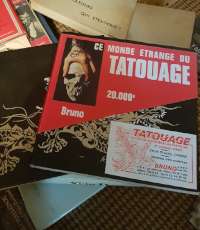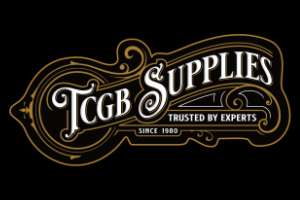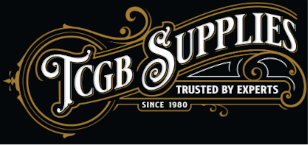Back to Top
July 19, 2012
97302

15 Tattoo Facts You Might Not Know
- The BBC’s ‘Pebble Mill’ afternoon TV show once played a video on the Dave Lee Travis segment entitled ‘Golden Oldies’. Which showed tattooing being done to the 1960’s pop tune ‘Needles and Pins’ by The Searchers.
- In the 1960s, the British comedy feature film ‘Up The Front’ starring Frankie Howerd had our hero playing a soldier of the First World War who had his regiments battle plans tattooed on his backside.
- The Tattoo Club of France is (as of 1987) based at 29 Rue Adolpe Thiers 13001, Marseille, France – with President Michel Burel and Vice-President Allan running the club.
- When Professor Rex Zeta tattooed in Blackpool, England, in the 1950’s he used to use toilet roll paper - which he liberated from Blackpool council’s public toilets so as to use as dressings for tattoos that he had inked. This was to save money on tissue paper. The only trouble was that the council’s paper had the property of Blackpool Corporation stamped all over it. Rex died in Plymouth, Devon, England, in 1982.
- Former Australian Heavyweight boxer and tattoo artist Pete Blackwell once tattooed with Max Chater at Max’s tattoo studio in the red light district of Sydney’s Kings Cross.
- Lou Gatto, a tattoo artist out of Amsterdam, New York, so upset his wife after an altercation that she put all of his plastic stencils into a pile and set them on fire. But instead of redrawing and engraving new ones, Lou carried on with his business by talking future customers into only having small tattoos that he could do freehand.
- In the days before stencil machines and photocopiers - tattooers would have to make their own stencils by engraving designs onto a plastic sheet. And when it was time for a stencil to be used, they would have to put black powder onto it and apply a sticky liquid solution to the part of the body where the design would be going, with the powdered stencil placed over the top. Which was not only, at times, a very messy procedure, but it was also a time-consuming job.
- Tattoo Artists of today have no such worries as anything, and everything can be bought via the internet from tattooing supply companies that offer ready-made needles and ready mixed colours. And no longer is it a vocational act of having to spend hours soldering needles onto needle bars and mixing your own colours. Even coloured design sheets come with line drawings that one just has to put into a stencil machine that will instantly make a perfect outline of the design for you, which is placed onto the skin via a watered-down solution of the tattoo artist’s choice and cutting even more time in the applying of a tattoo.
- Famed English naturalist Charles Robert Darwin (1809-1882) not only upset religious groups and scientists throughout the civilized world with his thoughts on evolution (that man descended from a lower animal form) via his books the origin of species (1859) and the descent of man (1871) - Also wrote of tattooing, and for this art form to be mentioned in such distinguished company made many people re-look at the tattoo, finding that they were standing at the dawn of a new era in indelible history. Darwin wrote about tattooing in his journals after meeting many natives with tattoo marks.
- Whether you love her art or hate it - there is little doubt - that London-born artist Tracey Emin (1963-) has certainly made many people in Great Britain sit up and take notice of just what she has been trying to say via her (some say) weird and wacky artworks over the years – And more importantly to tattoo art lovers Ms Emin sports a spider (scorpion) on the left-hand side shoulder blade of her back – A tattoo that can be seen on the cover of the ‘Sunday Times’ newspaper’s culture magazine of the 16th of October 2005 – And not only that - for Ms Emin looks quite the sex bomb in the nicely composed photograph on the cover of the very highbrow broadsheet publication.
- Zara Phillips (1981-), the stunning-looking daughter of Captain Mark Phillips (1948-) and Princess Anne (1950-), has a tongue piercing - and it is also rumoured (in royal circles) that she is also tattooed.
- In 2005 stunning Brazilian supermodel Gisele Bundchen(1980-) spent hours having a complete bodysuit of tattoos (painted on) to promote her own line of shoes that had just hit high street shops – The beautiful Ms Bundchen certainly looked like a tattooed masterpiece in the press photo’s that followed – and not only that – She was the girlfriend of Hollywood movie star Leonardo DiCaprio (1974-).
- It is also believed that many of the Anglo-Saxon kings of England were tattooed, but much of this was conjecture as the first true fact of royalty having been tattooed was King Harold II (1022-1066). At the famous battle of Hastings, his tattoos were recorded for prosperity. Romantically the plight of Harold Godwinson of Wessex, the last Anglo-Saxon king of England and his sad demise has somewhat had the overtones of a romantic fable. Rightly he died defending his country heroically, falling to blows from the swords of four Norman knights and not the popular belief that an arrow through the eye killed him. Although it is believed that a lucky arrow did indeed hit Harold in the eye, blinding him beforehand - and destroying the King's facial features. It was Harold’s mistress Edith Svanneshals and Mallet de Granville who found the Kings body many hours after the battle, and it was Edith who picked out the Kings mutilated remains because of the Saxon words Edith and England that were pricked (tattooed) on his chest. Harold’s remains were buried on the battlefield, and a memorial stone marks this on the grounds of Battle Abbey. Later the King was reburied in Waltham Abbey. The confusion surrounding Harold’s death arises from the Bayeux tapestry, which shows a soldier pulling an arrow from his eye and another warrior dying at the blade of a sword. William of Poitiers, who recorded the battle, noted that Harold was stripped of all regalia and could not be identified by his face, only by his body markings. Also, it must be said that the battle of Hastings should have been called the battle of Senlac Ridge, as this is where Harold fell on the 14th day of October 1066, eleven miles from the town of Hastings.
- Sir Martin Frobisher (1535-1595). One of England’s finest sailors set out in 1576 on the first of three unsuccessful voyages to find a northwest passage to China. Although without success, Frobisher did, however, find a certain amount of fame when he brought back to England an Eskimo woman called Arnaq, who had chin and forehead tattoos. Arnaq sadly died shortly after arriving in England and was buried at St Stephen’s church, Bristol, on the 12th of November 1577. The famed painter John White even painted her portrait, including her tattoos. In fact, Frobisher brought back four Inuit women between 1576 and 1577. Frobisher later went on to even greater achievements when in 1586, he sailed as vice-admiral in an expedition with Drake to the West Indies. And two years later was given charge of a ship that helped defeat the armada and so distinguished himself that he was knighted upon his own ship. Frobisher was later to die in battle from a fatal wound he received on the 14th of January 1595.
- By banning tattooing via the church in England in 787AD, tattooing became an activity that almost died out and certainly went underground until the golden age of the pirate and explorer. When tales and fables started to be told of marked people in far-off places by seamen, many became fascinated by what they were hearing and were more than eager to listen.
Paul Sayce
Copyright


